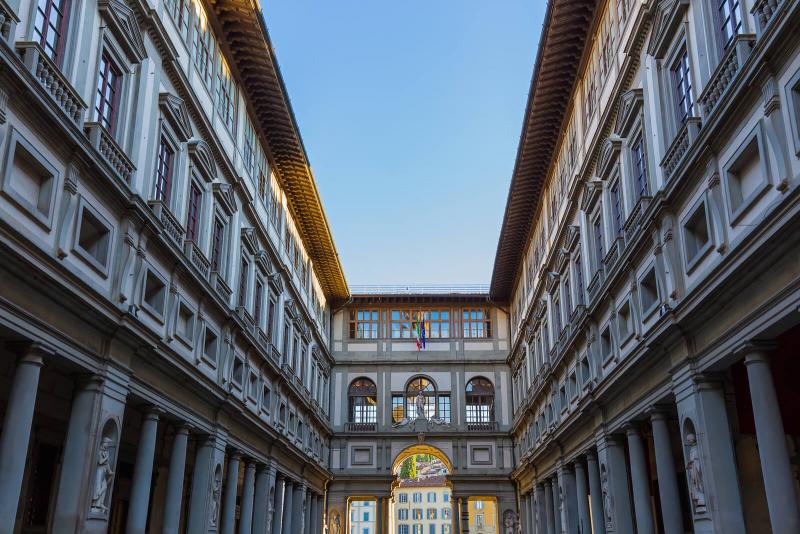Why Are They Called the 'Uffizi'?
ITA:

Use player to listen to Italian version
What today is one of the most visited Italian museums, the Uffizi Gallery, was not for a long time intended to be a public museum – the ‘Uffizi’ (offices in Italian) were created in 1560 to house the administrative and judiciary offices of Florence, hence the name the institution still goes by today.
In 1560, Cosimo I de’ Medici, known as Cosimo the Great, the first Grand Duke of Tuscany, ordered the construction of the building to none other than painter, architect, writer, and historian Giorgio Vasari, who was Cosimo’s favorite artist.
Vasari designed the building following a U-shape, with the offices facing across a courtyard, one end of the building opening onto the town square and the other opening onto the river Arno.
Vasari was also the one who built the secret corridor, known today as the Corridoio Vasariano, which connected the Uffizi to the Pitti Palace on the other side of the Arno (the palace was bought by the Medici family in 1549, and became the main residence of the ruling families of the Grand Duchy of Tuscany), passing above the Ponte Vecchio.
After Vasari’s death in 1574, the Uffizi building was completed by Bernardo Buontalenti, who was also tasked with the design of an octagonal room called the Tribune, which was to be the heart of what was originally intended as a private museum. In fact, Cosimo I had had the idea to place some the works of art owned by the family on the upper floors of the Uffizi, an idea that was realized by his son, Francesco I de’ Medici, the new Grand Duke of Tuscany, in 1581, when he set up a private gallery with statues and other precious objects on the top floor of the east wing of the Uffizi. Access to the gallery was only on request.
It was not until 1765 that the Uffizi Gallery was officially opened to the public, when the last Medici heiress, Anna Maria Lodovica, bequeathed most of the Medici collection from the past three centuries to the Tuscan state, requiring that it all stay in place and never leave Tuscany, declaring the Uffizi Gallery “an inalienable public good.”
Quello che oggi è uno dei musei italiani più visitati, la Galleria degli Uffizi, non fu inizialmente pensato come museo - gli ‘Uffizi’ furono creati nel 1560 per ospitare gli uffici amministrativi e giudiziari di Firenze; da qui il nome con cui l'edificio è conosciuto ancora oggi.
Nel 1560, Cosimo I de' Medici, noto come Cosimo il Grande, il primo Granduca di Toscana, ordinò la costruzione dell'edificio a nientemeno che il pittore, architetto, scrittore e storico Giorgio Vasari, che era il suo artista preferito.
Vasari progettò l'edificio secondo una forma a U, con gli uffici che si affacciavano su entrambi i lati di un cortile, un'estremità dell'edificio che si apriva sulla piazza della città e l'altra sul fiume Arno.
Vasari fu anche colui che costruì il corridoio segreto, conosciuto oggi come Corridoio Vasariano, che collegava gli Uffizi a Palazzo Pitti sull'altro lato dell'Arno (il palazzo fu acquistato dalla famiglia Medici nel 1549 e divenne la residenza principale delle famiglie del Granducato di Toscana).
Dopo la morte di Vasari nel 1574, l'edificio fu completato da Bernardo Buontalenti, che fu anche incaricato della progettazione di una sala ottagonale chiamata Tribuna, che doveva essere il cuore di quello che originariamente era stato pensato come un museo privato. Infatti, Cosimo I aveva avuto l'idea di collocare alcune opere d'arte di proprietà della famiglia ai piani superiori degli Uffizi, un'idea che fu concretizzata da suo figlio, Francesco I de' Medici, il nuovo Granduca di Toscana, nel 1581, quando fece allestire una galleria con statue e altri oggetti preziosi all'ultimo piano dell'ala orientale degli Uffizi. L'accesso alla galleria era esclusivamente su richiesta.
Fu solo nel 1765 che la Galleria degli Uffizi venne ufficialmente aperta al pubblico, quando l'ultima ereditiera dei Medici, Anna Maria Lodovica, lasciò la maggior parte della collezione medicea degli ultimi tre secoli allo stato toscano, imponendo che questa rimanesse nello stesso luogo e che non lasciasse mai la Toscana, dichiarando la Galleria degli Uffizi “un bene pubblico inalienabile”.











